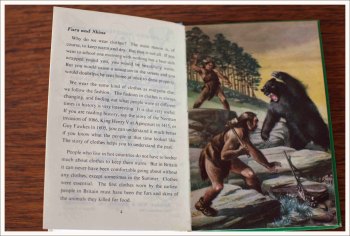Ladybird Books
Ladybird Books are 100 years old, but their golden age was in the 1950s-1970s, read by the generation born after the end of the Second World War. I was one of that generation, born in 1960. Ladybird books were a memorable part of my early childhood, and learning both to read and to see the world in pictures. I still have some of the books that I had then. Even without looking at them, I can recall them vividly, with virtually every detail of each page of their bright illustrations printed on my mind. A trip to the seaside, itself a very Ladybird kind of activity, to see the exhibition of some original drawings from the books, was irresistible.
Ladybird Achievements and mid-century optimism
Two of my favourites were from the Achievements series – the Story of Clothes and Costume, and the Story of Houses and Homes. The Story of Houses and Homes began with cavemen in bearskins lighting a fire and ended with blocks of flats described as being “as beautiful in their way as were the best of the past . . . and even more convenient and pleasant to live in”, a belief then unclouded by the experience of many of those who occupied them in the 1960s and 70s.
The Story of Clothes and Costume also started with cavemen in bearskins, fighting a large black bear for its skin, and ended with a 60s family having a picnic in their comfortable, easy and brightly coloured clothes. The theme of the two books was the same – sunny optimism in the present and its progress from the dark primitivism of the past. Both flats and family flourish under blue skies, not the thunderous clouds above the bear’s head in the picture below.

 One of the pictures in ‘Our Land in the Making’ illustrates the same theme in a single image: a new motorway running alongside a winding road through a traditional village:
One of the pictures in ‘Our Land in the Making’ illustrates the same theme in a single image: a new motorway running alongside a winding road through a traditional village:
Ladybird by Design at the De La Warr Pavilion
It’s ironic in a way that people of my generation feel such intense nostalgia for Ladybird, because that fond looking-over-the-shoulder at the past is the very opposite of the spirit of the books. But it was an inspired choice to exhibit some of the original drawings at the 1935 De La Warr Pavilion in Bexhill, a building which is a triumphantly progressive piece of architecture in the European Modernist style, an expression in a seaside building of the same belief in light, air and progress as in the Ladybird books.
I’ve visited the De La Warr Pavilion a number of times in different seasons and in different light, including the tupperware grey of light cloud that frequently covers the English sky in both summer and winter. The day that I went to see Ladybird by Design was an April day of brilliant sunshine but with a sharp breeze – a perfect day for appreciating the design of the Pavilion itself and for walking along the seaside path to Hastings afterwards.









[…] https://barbarakafka.wordpress.com/2015/05/30/ladybird-by-design-at-the-de-la-warr-pavilion/ […]
LikeLike